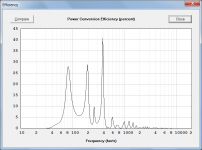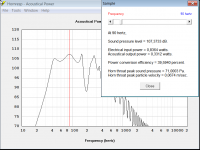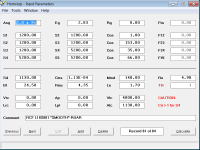The large front resonator increases the efficiency a lot, and especially so in the midbass.
Here is a picture of the difference when shortening the horn by 8,8cm
Black = without. Grey = with


This might work just fine. We did not like the spread between the midbass peak from the front resonator and the lower knee of the passband. This variation will also increase the vertical spread of the peaks somewhat. If you like it you are welcome to try it. We want to encourage experiments and general tinkering with our design.
If you test this variation, then please don't call it ROAR though. We are very interested in hearing about your findings if you try this variation.
If you are going to stack multiples of the ROAR horns then this would probably be a good tuning. The front resonator peak moves downward and the lower part of the passband gets very dominant with stacks of 4 (or more) of the ROAR series.
Thanks for your interest in our designs.
Regards,
Johannes
If you test this variation, then please don't call it ROAR though. We are very interested in hearing about your findings if you try this variation.
If you are going to stack multiples of the ROAR horns then this would probably be a good tuning. The front resonator peak moves downward and the lower part of the passband gets very dominant with stacks of 4 (or more) of the ROAR series.
Thanks for your interest in our designs.
Regards,
Johannes
Last edited:
Here is a picture of the difference when shortening the horn by 8,8cm
Yes, but it have enough (if not say excessive) response in 100 Hz range, it would be better to cover that range by low cone weight mids than tuning subs here.
Midbass punch mostly depends of Q and Bl/Mms.
Moreover, i'll prefer to tune front resonator a bit lower, this allow ROAR to reduce efficiency dip in 60-80 Hz range.
"Moreover, i'll prefer to tune front resonator a bit lower, this allow ROAR to reduce efficiency dip in 60-80 Hz range." There is no dip compared to the original design just a tad more mid peak, and if I have an excessive response in the around 100hz, then using what Circlomanen says about increased vertical spread around peaks, then the peak will be lowered over distance. And if that doesn't do the job. EQ'ing can always help me. Can you also elaborate on: "it would be better to cover that range by low cone weight mids than tuning subs here."
I won't name it. If I had to then probably Groar. G for Grymer hehe
I just calculated the weight w/o driver and the weight (in birch 18mm) is 41,26kg. Shortening the horn will make the speaker 10% lighter and 8,8cm shorter. And from what I have analyzed in House EDM (Which is very popular here in DK), normal tuning might be a tad too low when stacked or indoor.
I'll build one and then build three more if I like it.
5. "If you test this variation, then please don't call it ROAR though. We are very interested in hearing about your findings if you try this variation."
I won't name it. If I had to then probably Groar. G for Grymer hehe
I just calculated the weight w/o driver and the weight (in birch 18mm) is 41,26kg. Shortening the horn will make the speaker 10% lighter and 8,8cm shorter. And from what I have analyzed in House EDM (Which is very popular here in DK), normal tuning might be a tad too low when stacked or indoor.
I'll build one and then build three more if I like it.
Last edited:
normal tuning might be a tad too low when stacked or indoor.
I'll build one and then build three more if I like it.
This sounds like a plan!! 🙂
Regards,
Johannes
This sounds like a plan!! 🙂
Regards,
Johannes
Oh and general question. At what point does bass become "omnidirectional". Not as in - At what point can we not tell where it is coming from, but at what point does the bass fly in every direction contra high frequencies that travel one way?
"Moreover, i'll prefer to tune front resonator a bit lower, this allow ROAR to reduce efficiency dip in 60-80 Hz range." There is no dip compared to the original design just a tad more mid peak
No, i say about dip in the power conversion efficiency, not frequency response.
😉
Can you also elaborate on: "it would be better to cover that range by low cone weight mids than tuning subs here."
All was done many years ago. What kind of info do you need?
Tell us about your system, event types, auditory and premise. Tops, mids, amps, music, peoples and listening goals.
At what point can we not tell where it is coming from, but at what point does the bass fly in every direction contra high frequencies that travel one way?
When 20 cm base between your ears would >20 times smaller that wavelength.
Can you also elaborate on: "it would be better to cover that range by low cone weight mids than tuning subs here."
My ROAR12 is easy to cross over at 120 Hz. I can cross it at 150 Hz but it does not sound "right". I guess I could make it better with some DSP, but I prefer crossing over at 120 Hz or lower.
The peak in the midbass of the larger ROAR18 is not meant to replace midbass horns or top speakers with a great punch and energy in the midbass. It does however make it much easier to cross over from the quite brutal 18 inch bass-driver to a high efficiency low mms, low Qes punchy and fun midbass drivers like a Beyma 15P80Nd, B&C 15FW76 or a RCF MB15N351 to name a few. I would guess you can cross it over at 100 Hz or slightly above with ease and a great sound quality. The ROAR18 should deliver a much better midbass punch then many other 18 inch tapped horns. It is quite dependent on the chosen driver, and once again a high Bl, low Qes and low Qts is your friend.
A slightly higher tuned frontresonator will enhance the midbass, and probably simplify the crossover to the top system.
a high efficiency low mms, low Qes punchy and fun midbass drivers like a Beyma 15P80Nd, B&C 15FW76 or a RCF MB15N351 to name a few.
Very good performers, but let me disagree.
Follow the thought.
Why try to reproduce sounds from high-Q drums with low-Q drivers charging a lot of power?
Just try to do it straight to reverse, try to use high-Q driver with reasonably low tuning and you will be unbelievably satisfied with results. This kind of mid-basses with low-powered amps sounds very angry and much more likely to mid-drum in comparison to low-Q drivers with high-powered amps.
Last edited:
No, i say about dip in the power conversion efficiency, not frequency response.
😉
All was done many years ago. What kind of info do you need?
Tell us about your system, event types, auditory and premise. Tops, mids, amps, music, peoples and listening goals.
When 20 cm base between your ears would >20 times smaller that wavelength.
Can I see power conversion efficiency on hornresp?
Depending on the setup my whole setup will be consisting of
Tops:
2x SRM450
2x Cubo18
For bigger events:
4x Soundgear orbit 4
2-4 Groar
Driving it:
iNukes and if I'm lucky a Digam5000 or 7000 for subs 🙂
And thanks for the response Circlo. I didn't get that he was refering to smaller drivers for kick. The orbit 4 have a sweet kick (according to my friend) and it is crossed at 80hz, so they should match well!
Can I see power conversion efficiency on hornresp?
Yes.
Attachments
You'll definitely need more than 2 'groar' for 4x Soundgear Orbits. Even 1:1 ratio will be quite top heavy.
Can I see power conversion efficiency on hornresp?
Of course!
While seeing to SPL response select "Tools" -> "Efficiency"
http://www.diyaudio.com/forums/subwoofers/309303-roar18-3.html#post5139308
Depending on the setup my whole setup will be consisting of
Ok, that's pretty good.
Mine preferred:
DBX Driverack PA/260
RCF 4PRO 4001/6001 (they're very old, but we can't find anything better)
+ some 18" subs with mighty H-class amps based on event and available space.
[OFF]Will you try to build a pair of speakers with uneven good performance for the price around of 1/20 of the Orbits pair?
You will need two sheets of 20 mm plywood with easiest cutting and two $20 drivers. And, of course, you can be sure you haven't heard nothing similar, especially for the price. I'm oftenly use them for side/back sounding and they're good even in the light of the shining star like RCF's[/OFF]
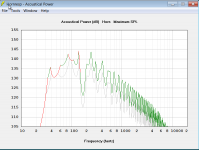
This is the Fane Colossus Prime 18 in a ROAR18. Grey curve is 1200 watt and 12 mm xmax.
The black curve is the same 12 mm xmax but with the maximum stated 4800 watts peak power.
The Soundgear Orbits has a calculated max spl of 129 dB in the midbass and a peak output of 135 dB.
They seems to match nicely in a 1:1 ratio.
Cheers,
Johannes
Why try to reproduce sounds from high-Q drums with low-Q drivers charging a lot of power?
Just try to do it straight to reverse, try to use high-Q driver with reasonably low tuning and you will be unbelievably satisfied with results. This kind of mid-basses with low-powered amps sounds very angry and much more likely to mid-drum in comparison to low-Q drivers with high-powered amps.
Low Q and High Bl drivers are much more efficient then high Q low Bl drivers, even though they need more voltage to get the power through their highly reactive motors.
I have never tried your idea with high Q drivers, so I will not criticize it.
I like low Q, high Bl drivers in a resonant tuning. The high Q midbass peak in the ROAR series has some similarities with the high Q peaks of drums.
But the ROAR needs a powerful motor to drive and control those resonant peaks.
I have been pondering a much larger ROAR18 tuned specifically for the rather unique RCF L18S801. That driver has a reputation of very sharp transients and a great midbass punch. This combined with the nice resonant midbass peak in the ROAR type of bass box should be really fun and entertaining with drums and other peaky, transient midbass sources.
It is a quite old driver with substandard xmax, weak suspensions and a delicate cone compared to modern alternatives. The ROAR is very careful and soft on the drivers due to a symmetric loading, no skewing warping forces on the cone and suspensions and a large cross section of the tapped pipe (low compression). It could be a real killer for fun punchy midbass.
Regards,
Johannes
Low Q and High Bl drivers are much more efficient then high Q low Bl drivers
Yes, but high Bl as a driving force at the same time means the high brake force while connected to the powerful and having low output resistance amp.
But you know, that a drum membrane only radiates having low brake, being only damped by connected air plus soundwave going away.
That's a true pulse excitated and resonant system with high-Q like a bell.
Just try it. You need to hear.
It doesn't cost a much and could deliver disproportionally its price.
Pick some cheap as dirt wideband guitar cabinet drivers like this:
Fonics HWC8-12MA300 Fonics
And place it in the front-loaded horn + rear chamber like this:
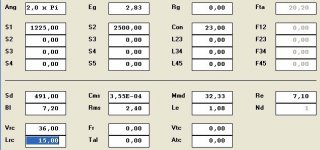
Take plywood sheet and provide simple cutting:
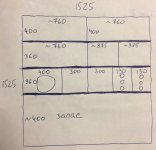
Use screws to build simple, very stiffy and well-sealed-around case:
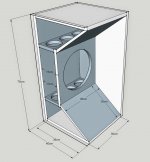
You can be sure, friend of your son will tear off it with your hands while hear.
You have heard violent rattle of anything from ROAR as sub, now you can check what a peppy and cheerful rattle could be from high-Q mids.
1:1 is reasonable but 2 tops to 3 bass per stack would be advisable. The kick section of the Orbit's being bandpass horn it'll get a fair old efficiency boost in pairs.They seems to match nicely in a 1:1 ratio.
Distribution of energy in actual music program means you can easily get away with EQ'ing up any slight dip that might remain in the upper bass with that arrangement.
Last edited:
- Home
- Loudspeakers
- Subwoofers
- ROAR18
